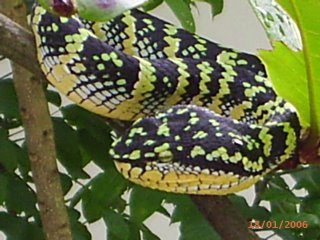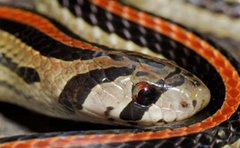We are lucky or what?
A pair of juvenile Wagler's Pit-vipers (Tropidolaemus/Trimeresurus wagleri) were spotted at about 3 metres from each other in the forest of Bukit Timah on 30 June 2007. They were probably ambushing geckos that are common at the rocky habitat.
A pair of juvenile Wagler's Pit-vipers (Tropidolaemus/Trimeresurus wagleri) were spotted at about 3 metres from each other in the forest of Bukit Timah on 30 June 2007. They were probably ambushing geckos that are common at the rocky habitat.
First snake:

Second snake:

Close-ups of the head:


Characteristic pose of this pit-viper:

The brown colour tail tip that is extremely prehensile:

* All photographs by Chim Chee Kong
Previous posts on this snake here and here.









